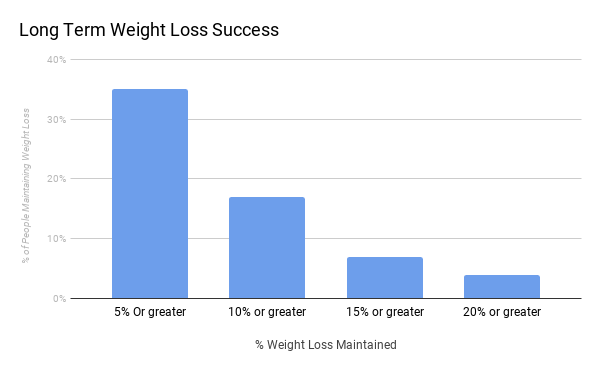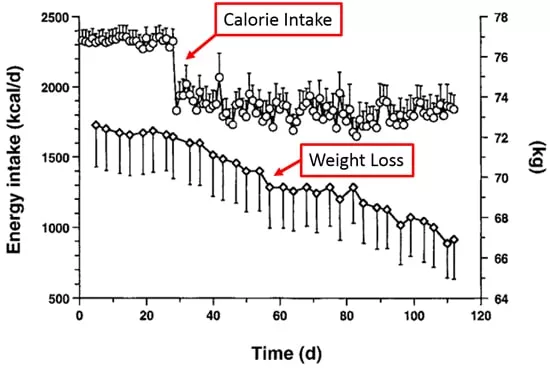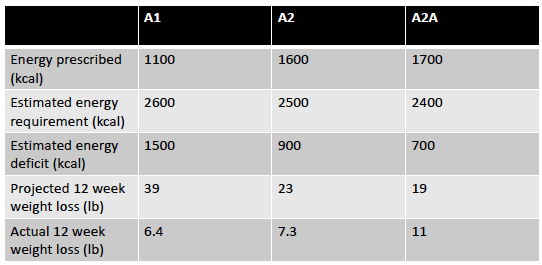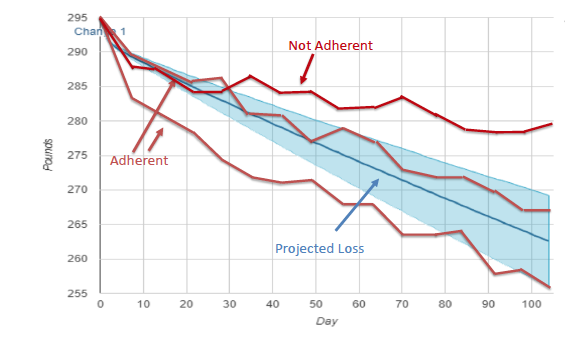
Satiety Improves Adherence: Characteristics of a High Satiety Diet include the following
-High protein
-High fibre
-Low energy density
-Moderate palatability
-Reduced variety
-Reduced reward
High protein is very important for dietary adherence as it helps you to stay full. Protein is the most satiating macronutrient, followed by carbs and then fats.
Fibre is often overlooked when seeking weight loss, but it’s essential for gut health and slowing down the absorption of food, keeping you fuller for longer. A general rule for fibre is 10-15 grams for every 1000 calories consumed. Hydration is also often overlooked, the reality is that when people think they are hungry, they are actually dehydrated. Staying hydrated will help you reduce the feeling of hunger and therefore less likely to deviate from the diet.

Add Barriers- Don’t buy it, lock it away (vending machine study). If the food is in view, you are more likely to consume. If you didn’t have the food in the house in the first instance, you are less likely to drive to the shop and buy it.
In regard to food and adhering to a diet, there are numerous physiological, psychological and environmental barriers that need to be considered.
First of all, let’s look at physiological barriers. When dieting we can be aggressive or cautious depending on your goal. Initially you will achieve greater weight loss with a greater calorie deficit (30%) but at the expense of increased hunger levels which can lead to reduced adherence and slower weight loss (you push yourself too hard and end up consuming more calories).
The following chart shows people lost more weight over the long term with a small calorie deficit (1700 kcal) compared to a large deficit (1100 kcal)

Reducing palatability/reward and therefore the variety of food available will automatically reduce the risk of overeating. This doesn’t mean needing to start following a ‘bro diet’ of chicken and broccoli, but simply reducing your food choice. This will also help you achieve more structure and consistency to your diet, therefore having more control of your calorie intake. Chris Voigt took this to the extreme by only eating potatoes and a small amount of cooking oil for 60 days and lost 21 pounds without trying, without the feeling of being hungry and consciously trying to reduce calories.
Environmental Techniques To Improve Adherence
The best way to improve adherence through your environment is to lower the value of food that you crave and overindulge in. To clarify my point, answer me this ‘How many burgers and fries would you eat if you had to climb a tree every time you needed to get them?’ (Guyenet, The Hungry Brain, 2017)
To conclude, make it more difficult to access foods that are likely to make you less adherent. Here are a few suggestions on how you can improve your food environment to reduce the risk of overindulgence:
-Out of sight
-Locked away
-Requires preparation (less likely to eat it)
Or better still, don’t buy ‘problem’ foods in the first place, if it’s not in the house, you can’t eat it.
Psychological Techniques To Improve Adherence
The reality is that the majority of us know how to lose weight, it’s just having the mindset to do so. Learning about nutrition and finding out what ‘diet’ works best for you is pretty useless if there are certain behavioural patterns that prevent you from executing the diet 100%. As soon as you can establish your behaviours and why you eat the way you do e.g. binging, you can then start to work on implementing strategies to help you improve adherence.
Indicators Of Long-Term Success
The majority have lost weight in the past, and then gained some, if not all, of the weight further down the line. Here are a few questions you need to ask yourself:
How are you getting on with your current diet?
Are you able to adhere to it?
Do you enjoy it?
These are the questions that you need to ask yourself because if you answered no to the first 2 then you will not be in adherent in the long term. The following graph shows a strong correlation between being adherent and the projected weight loss, meaning if you adhere to the diet, you will lose weight. When you stop being adherent, that’s when weight loss starts to slow down and level out which the graph illustrates. The success of a diet in the short term is a great indicator of long-term weight loss.
Kevin Hall’s Model To Assess Dietary Adherence Over The Long Term

1. Avoid situations that you know that will invite temptation e.g. buffets. Why make things difficult for yourself? If you remove the temptation then you are less likely to relapse.
2. Practice mindful eating. Being aware of what you are eating can help you make an informed decision and acknowledge your food choices. It’s too easy to snack and not even realise you’ve just consumed 1000 calories, but in your mind, you’ve only had a small snack.
3. There are going to be times that we deviate from the ‘diet’, it’s important to understand that this is normal and part of any weight loss journey. It’s how you are able to get back on track and find ways to cope with temporary lapses that will determine long-term weight loss success
4. Accountability as part of your weight loss journey will help you focus on keeping to the plan as you won’t only be letting yourself down, but other people.
5. Create a consistent routine and good habits will mean you will do what is needed in order to make progress more consistently without consciously having to think about it. Examples of this would be consuming a high protein breakfast, walking 10,000 steps a day and going to the gym 3 times a week.
6. The ability to manage hunger and low energy will be key if you are going to adhere to the diet. Losing weight means you will be a in a calorie deficit so there will probably be times when you will feel hungry. There are a few things you can do to help, including low calorie/high volume foods, calorie-free drinks, staying hydrated and spreading your meals throughout the day.
7. Self -monitoring correlates positively with adherence. For example, getting into a routine of tracking your weight, doing monthly before/after pictures, tracking calories and tracking workout will help you to focus on achieving your goal.
8. A supportive and stable environment is important for long-term weight loss. Losing weight can be challenging at times, the support of people around you can have a significant impact by affording encouragement needed to manage the more difficult times.
9. Motivation is worth little without a specific plan in place. Create short-term goals for yourself, for example 10,000 steps daily, 1 pound weight loss a week, hitting your daily calorie goals. You are more likely to implement positive behavioural changes if you have goals to focus on.

Recent Comments